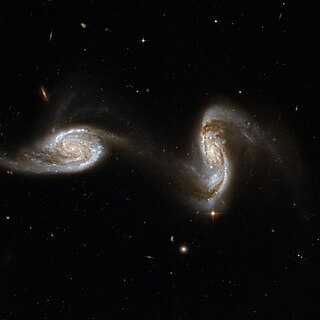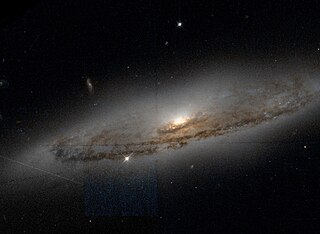
NGC 6744 is an intermediate spiral galaxy in the constellation Pavo (Peacock). Its velocity with respect to the cosmic microwave background is 802 ± 3 km/s, which corresponds to a Hubble distance of 38.6 ± 2.7 Mly (11.82 ± 0.83 Mpc). However, 21 non redshift measurements give a distance of 23.63 ± 1.68 Mly (7.244 ± 0.514 Mpc). It was discovered on 30 June 1826 by Scottish astronomer James Dunlop, observing from Parramatta, Australia.

NGC 5921 is a barred spiral galaxy located approximately 65 million light-years from the Solar System in the constellation Serpens Caput. It was discovered by William Herschel on 1 May 1786. In February 2001 a type II supernova was discovered in NGC 5921. It is a member of the Virgo III Groups, a series of galaxies and galaxy clusters strung out to the east of the Virgo Supercluster of galaxies.

Arp 240 is a pair of interacting spiral galaxies located in the constellation Virgo. The two galaxies are listed together as Arp 240 in the Atlas of Peculiar Galaxies. The galaxy on the right is known as NGC 5257, while the galaxy on the left is known as NGC 5258. Both galaxies are distorted by the gravitational interaction, and both are connected by a tidal bridge, as can be seen in images of these galaxies.

NGC 5792 is a barred spiral galaxy about 70 million light-years away in the constellation Libra. There is a magnitude 9.6 star on the northwestern edge of the galaxy. It was discovered on April 11, 1787, by the astronomer William Herschel. It is a member of the Virgo III Groups, a series of galaxies and galaxy clusters strung out to the east of the Virgo Supercluster of galaxies.

NGC 7840, the last numerical entry in the New General Catalogue, is an unbarred spiral galaxy in the constellation Pisces. Its velocity with respect to the cosmic microwave background is 10906 ± 49 km/s, which corresponds to a Hubble distance of 160.85 ± 11.30 Mpc, and its diameter is about 162,000 light-years. It was discovered by German astronomer Albert Marth on 29 November 1864.

NGC 4697 is an elliptical galaxy some 40 to 50 million light-years away in the constellation Virgo. It is a member of the NGC 4697 Group, a group of galaxies also containing NGC 4731 and several generally much smaller galaxies. This group is about 55 million light-years away; it is one of the many Virgo II Groups, which form a southern extension of the Virgo Supercluster of galaxies.

NGC 5746 is a barred spiral galaxy located in the eastern part of the constellation of Virgo. It was discovered on 24 February 1786 by German-British astronomer William Herschel. It is the lead member of the NGC 5746 Group of galaxies, itself one of the Virgo III Groups strung out to the east of the Virgo Supercluster of galaxies.

NGC 4845 is a spiral galaxy located in the constellation Virgo around 65 million light years away. The galaxy was originally discovered by William Herschel in 1786. It is a member of the NGC 4753 Group of galaxies, which is a member of the Virgo II Groups, a series of galaxies and galaxy clusters strung out from the southern edge of the Virgo Supercluster.

NGC 2300 is a lenticular galaxy in the constellation Cepheus. Its velocity with respect to the cosmic microwave background is 1876 ± 7 km/s, which corresponds to a Hubble distance of 90.2 ± 6.3 Mly (27.67 ± 1.94 Mpc). However, 11 non redshift measurements give a distance of 131.98 ± 21.75 Mly (40.464 ± 6.668 Mpc). The galaxy was discovered in 1871 by French astronomer Alphonse Borrelly using an 18 cm telescope.

NGC 4694 is a lenticular galaxy in the constellation Virgo. Its velocity with respect to the cosmic microwave background is 1481 ± 23 km/s, which corresponds to a Hubble distance of 71.3 ± 5.1 Mly (21.85 ± 1.57 Mpc). However, six non redshift measurements give a distance of 28.51 ± 7.23 Mly (8.742 ± 2.218 Mpc). The galaxy was discovered by William Herschel on March 15, 1784.

NGC 6365 is a pair of spiral galaxies in the constellation Draco. It consists of two galaxies, PGC 60174 to the south, and PGC 60171 to the north. These two galaxies are also designated respectively by the NASA/IPAC database as NGC 6365A and NGC 6365B. This pair of galaxies was discovered by German astronomer Lewis Swift in 1884.

NGC 2937 is an elliptical galaxy located in the constellation Hydra. Its velocity relative to the cosmic microwave background is 105.1 ± 7.4 km/s, which corresponds to a Hubble distance of 105.1 ± 7.4 Mpc. NGC 2937 was discovered by German astronomer Albert Marth in 1864.

NGC 7253 is a pair of spiral galaxies in the constellation Pegasus. It was discovered by the German-British astronomer Albert Marth on 9 September 1863. It is listed in Halton Arp's Atlas of Peculiar Galaxies as Arp 278, as an example of gravitationally interacting galaxies.

NGC 5377 is an intermediate barred spiral galaxy located in the constellation Canes Venatici. Its speed relative to the cosmic microwave background is 1,951 ± 11 km/s, which corresponds to a Hubble distance of 28.8 ± 2.0 Mpc. NGC 5377 was discovered by German-British astronomer William Herschel in 1787.

NGC 5898 is an elliptical galaxy in the constellation of Libra. Its velocity with respect to the cosmic microwave background is 2301 ± 13 km/s, which corresponds to a Hubble distance of 33.93 ± 2.38 Mpc. It was discovered by German-British astronomer William Herschel on 21 May 1784.

NGC 2283 is a barred spiral galaxy in the constellation of Canis Major. Its velocity with respect to the cosmic microwave background is 994 ± 11 km/s, which corresponds to a Hubble distance of 14.66 ± 1.04 Mpc. It was discovered by German-British astronomer William Herschel on 6 February 1785.

NGC 4330 is a spiral galaxy in the constellation of Virgo. Its velocity with respect to the cosmic microwave background is 1898 ± 24 km/s, which corresponds to a Hubble distance of 27.99 ± 1.99 Mpc. However, a dozen non-redshift measurements give a distance of 19.642 ± 1.559 Mpc. The galaxy was discovered by Irish engineer Bindon Stoney on 14 April 1852.

NGC 3914 is a barred spiral galaxy in the constellation of Virgo. Its velocity with respect to the cosmic microwave background is 6466 ± 25 km/s, which corresponds to a Hubble distance of 95.38 ± 6.69 Mpc. However, six non-redshift measurements give a distance of 81.2 ± 2.8 Mpc. The galaxy was discovered by German-British astronomer William Herschel on 13 April 1784.

NGC 1385 is a barred spiral galaxy in the constellation of Fornax. Its velocity with respect to the cosmic microwave background is 1381 ± 9 km/s, which corresponds to a Hubble distance of 20.37 ± 1.43 Mpc. In addition, 30 non redshift measurements give a distance of 15.999 ± 12.131 Mpc. The galaxy was discovered by German-British astronomer William Herschel on 17 November 1784.

NGC 5162 is a very large spiral galaxy in the constellation of Virgo. Its velocity with respect to the cosmic microwave background is 7125 ± 20 km/s, which corresponds to a Hubble distance of 342.8 ± 24.0 Mly (105.09 ± 7.36 Mpc). In addition, 11 non redshift measurements give a distance of 303.71 ± 12.41 Mly (93.118 ± 3.806 Mpc). The galaxy was discovered by German-British astronomer William Herschel on 15 March 1784. It was also observed by Lewis Swift on 19 April 1887, resulting in the galaxy being included twice in the New General Catalogue, as both NGC 5162 and NGC 5174.























